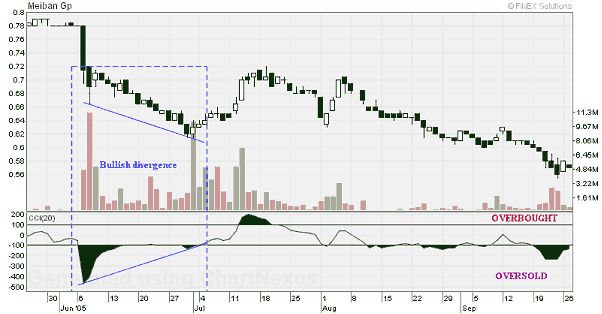Commodity Channel Index (CCI)
Overview
Developed by Donald Lambert, Commodity Channel Index (CCI) measures the variation of a security's price from its statistical mean. High values show that prices are unusually high as compared to the average prices; whereas low values show that prices are unusually low as compared to the average prices.
Contrary to its name, CCI can be used effectively on any type of security; not just commodities (Achiles 1995).
How it is calculated
The assumption behind the indicator is that securities move in cycles, with highs and lows coming at periodic intervals. Lambert recommended using 1/3 of a complete cycle (low to low or high to high) as a time frame for the CCI that is if the cycle runs 60 days (a low about every 60 days), then a 20-day CCI would be recommended.
A 20-day CCI is calculated with the following basic steps:

How to interpret
Extreme Readings
CCI typically oscillates between 100. Readings above +100 implies an overbought condition (and a pending price correction) while readings below -100 implies an oversold condition (and a pending rally) (Achiles 1995).
Crossing Centerline
CCI gives a buy signal when it moves through its oversold level on its way back to zero. Sell signals are generated when it re-crosses its way back to zero (Pring 1993).
Divergence Analysis
A bearish divergence occurs when prices are making new highs while CCI fails to surpass its previous highs. On the other hand, a bullish divergence occurs when prices are making new lower lows while CCI is making higher lows.
Example

Meiban Group displayed a bullish divergence on June 2005. While price was making a lower low, CCI made a higher low. Prices moved up following this divergence as well as CCI. Notice that when CCI's reading was above +100 (overbought condition), Meiban Group displayed price weaknesses. On the other hand, when CCI's reading was below -100 (oversold condition), price strengthen.
Rules available in ChartNexus
CCI lies above/below +100/-100
- CCI lies below -100
- CCI lies above +100
Parameters available:
- Period - the number of days used in the calculation of CCI
- x - the minimum amount CCI has to lie above +100 or below -100
- t - the maximum number of days for CCI to rise x above +100 or fall x below -100
CCI Centerline Crossover
- CCI crosses over centerline
- CCI crosses below centerline
Parameters available:
- Period - the number of days used in the calculation of CCI
- x - the minimum amount CCI has to move above or below the centerline after a bullish or bearish crossover respectively
- t - the maximum number of days for CCI to rise x above or below the centerline after the bullish or bearish crossover respectively
CCI rebounding/retreating in the regions below/above -100/+100
- CCI rebounds from low in region below -100
- CCI retreats from high in region above +100
Parameters available:
- Period - the number of days used in the calculation of CCI
- x - the amount that CCI has to rebound/retreat from its low/high in the regions below/above -100/+100
- t - the maximum number of days for CCI for x to develop
CCI Rebounded/Retreated Regions below/above -100/+100 And Touching/Crossing -100/+100
- CCI crosses back -100 from low in the region below -100
- CCI crosses back +100 from high in the region above +100
Parameters available:
- Period - the number of days used in the calculation of CCI
- x - the minimum amount between the low and the -100 level or between the high and the +100 level
- t - the maximum number of days for x to develop
Buy signal
- Reading below -100
- Positive divergence below -100 based on a move back above -100
- Crossing up from the centerline
Sell signal
- Reading above +100
- Negative divergence above +100 based on a move back below +100
- Crossing down from the centerline
References :
- Achelis, S. B., Technical Analysis from A to Z, 1995
- Pring, M. J., Technical Analysis Explained, 2002
